Passively Mode-Locked Er-Doped Fiber Laser Based on Sb2S3-PVA Saturable Absorber
Abstract
:1. Introduction
2. Preparation and Characterization of Sb2S3
2.1. Preparation of Sb2S3-PVA SA
2.2. Characterization of Sb2S3 and Sb2S3-PVA Film
3. Experimental Setup
4. Experimental Results and Discussion
5. Conclusions
Author Contributions
Funding
Institutional Review Board Statement
Informed Consent Statement
Data Availability Statement
Conflicts of Interest
Sample Availability
References
- Phillips, K.C.; Gandhi, H.H.; Mazur, E.; Sundaram, S.K. Ultrafast laser processing of materials: A review. Adv. Opt. Photonics 2015, 7, 684–712. [Google Scholar] [CrossRef]
- Guo, B.; Xiao, Q.; Wang, S.; Zhang, H. 2D layered materials: Synthesis, nonlinear optical properties, and device applications. Laser Photonics Rev. 2019, 13, 1800327. [Google Scholar] [CrossRef]
- Wayne, H.K. Ultrafast technology in telecommunications. IEEE J. Sel. Top. Quant. 2000, 6, 1273–1278. [Google Scholar]
- Fermann, M.E.; Hartl, I. Ultrafast fibre lasers. Nat. Photonics 2013, 7, 868–874. [Google Scholar] [CrossRef]
- Nishizawa, N. Ultrashort pulse fiber lasers and their applications. Japan J. Appl. Phys. 2014, 53, 090101. [Google Scholar] [CrossRef]
- Wu, K.; Chen, B.; Zhang, X.; Zhang, S.; Guo, C.; Li, C.; Xiao, P.; Wang, J.; Zhou, L.; Zou, W.; et al. High-performance mode-locked and Q-switched fiber lasers based on novel 2D materials of topological insulators, transition metal dichalcogenides and black phosphorus: Review and perspective. Opt. Commun. 2018, 406, 214–229. [Google Scholar] [CrossRef]
- Nelson, L.E.; Jones, D.J.; Tamura, K.; Haus, H.A.; Ippen, E.P. Ultrashort-pulse fiber ring lasers. Appl. Phys. B 1997, 65, 277–294. [Google Scholar] [CrossRef] [Green Version]
- Chang, Y.; Kim, H.; Lee, J.; Song, Y. Multilayered graphene efficiently formed by mechanical exfoliation for nonlinear saturable absorbers in fiber mode-locked lasers. Appl. Phys. Lett. 2010, 97, 211102. [Google Scholar] [CrossRef]
- Liu, X.; Yang, H.; Cui, y.; Chen, G.; Yang, Y.; Wu, X.; Yao, X.; Han, D.; Han, X.; Zeng, C.; et al. Graphene-clad microfibre saturable absorber for ultrafast fibre lasers. Sci. Rep. 2016, 6, 26024. [Google Scholar] [CrossRef] [Green Version]
- He, X.; Liu, Z.; Wang, D.; Yang, M.; Liao, C.R.; Zhao, X. Passively mode-locked fiber laser based on reduced graphene oxide on microfiber for ultra-wide-band doublet pulse generation. J. Lightwave Technol. 2012, 30, 984–989. [Google Scholar] [CrossRef]
- Fu, B.; Sun, J.; Wang, C.; Shang, C.; Xu, L.; Li, B.; Zhang, H. MXenes: Synthesis, optical properties, and applications in ultrafast photonics. Small 2021, 17, 2006054. [Google Scholar] [CrossRef] [PubMed]
- Popa, D.; Sun, Z.; Hasan, T.; Cho, W.B.; Wang, F.; Torrisi, F.; Ferrari, A.C. 74-fs nanotube-mode-locked fiber laser. Appl. Phys. Lett. 2012, 101, 153107. [Google Scholar] [CrossRef]
- Lodari, M.; Tosato, A.; Sabbagh, D.; Schubert, M.A.; Capellini, G.; Sammak, A.; Veldhorst, M.; Scappucci, G. Light effective hole mass in undoped Ge/SiGe quantum wells. Phys. Rev. B 2019, 100, 041304. [Google Scholar] [CrossRef] [Green Version]
- Mao, D.; Li, M.; Cui, X.; Zhang, W.; Lu, H.; Song, K.; Zhao, J. Stable high-power saturable absorber based on polymer-black-phosphorus films. Opt. Commun. 2018, 406, 254–259. [Google Scholar] [CrossRef]
- Liu, H.; Zheng, X.; Liu, M.; Zhao, N.; Luo, A.; Luo, Z.; Xu, W.; Zhang, H.; Zhao, C.; Wen, S. Femtosecond pulse generation from a topological insulator mode-locked fiber laser. Opt. Express 2014, 22, 6868–6873. [Google Scholar] [CrossRef] [Green Version]
- Mao, D.; Jiang, B.; Gan, X.; Ma, C.; Chen, Y.; Zhao, C.; Zhang, H.; Zheng, J.; Zhao, J. Soliton fiber laser mode locked with two types of film-based Bi2Te3 saturable absorbers. Photonics Res. 2015, 3, A43–A46. [Google Scholar] [CrossRef]
- Sotor, J.; Sobon, G.; Macherzynski, W.; Paletko, P.; Grodecki, K.; Abramski, K.M. Mode-locking in Er-doped fiber laser based on mechanically exfoliated Sb2Te3 saturable absorber. Opt. Mater. Express 2014, 4, 1–6. [Google Scholar] [CrossRef]
- Choi, W.; Choudhary, N.; Han, G.; Park, J.; Akinwande, D.; Lee, Y. Recent development of two-dimensional transition metal dichalcogenides and their applications. Mater. Today 2017, 20, 116–130. [Google Scholar] [CrossRef]
- Khazaeizhad, R.; Kassani, S.H.; Jeong, H.; Yeom, D.; Oh, K. Mode-locking of Er-doped fiber laser using a multilayer MoS2 thin film as a saturable absorber in both anomalous and normal dispersion regimes. Opt. Express 2014, 22, 23732–23742. [Google Scholar] [CrossRef]
- Luo, Z.; Li, Y.; Zhong, M.; Huang, Y.; Wan, X.; Peng, J.; Weng, J. Nonlinear optical absorption of few-layer molybdenum diselenide (MoSe2) for passively mode-locked soliton fiber laser. Photonics Res. 2015, 3, A79–A85. [Google Scholar] [CrossRef]
- Yan, P.; Liu, A.; Chen, Y.; Wang, J.; Ruan, S.; Chen, H.; Ding, J. Passively mode-locked fiber laser by a cell-type WS2 nanosheets saturable absorber. Sci. Rep. 2015, 5, 12587. [Google Scholar] [CrossRef] [PubMed] [Green Version]
- Zhu, X.; Chen, S.; Zhang, M.; Chen, L.; Wu, Q.; Zhao, J.; Jiang, Q.; Zheng, Z.; Zhang, H. TiS2-based saturable absorber for ultrafast fiber lasers. Photonics Res. 2018, 6, C44–C48. [Google Scholar] [CrossRef]
- Long, H.; Tang, C.; Cheng, P.; Wang, X.; Qarony, W.; Tsang, Y. Ultrafast laser pulses generation by using 2D layered PtS2 as a saturable absorber. J. Lightwave Technol. 2019, 37, 1174–1179. [Google Scholar] [CrossRef]
- Zhang, K.; Feng, M.; Ren, Y.; Liu, F.; Chen, X.; Yang, J.; Yan, X.; Song, F.; Tian, J. Q-switched and mode-locked Er-doped fiber laser using PtSe2 as a saturable absorber. Photonics Res. 2018, 6, 893–899. [Google Scholar] [CrossRef] [Green Version]
- Gonzalez, J.M.; Oleynik, I.I. Layer-dependent properties of SnS2 and SnSe2 two-dimensional materials. Phys. Rev. B 2016, 94, 125443. [Google Scholar] [CrossRef] [Green Version]
- Xu, N.; Wang, H.; Zhang, H.; Guo, L.; Shang, X.; Jiang, S.; Li, D. Palladium diselenide as a direct absorption saturable absorber for ultrafast mode-locked operations: From all anomalous dispersion to all normal dispersion. Nanophotonics 2020, 9, 4295–4306. [Google Scholar] [CrossRef]
- Lee, C.; Hong, J.; Whangbo, M.H.; Shim, J.H. Enhancing the thermoelectric properties of layered transition-metal dichalcogenides 2H-MQ2 (M = Mo, W.; Q = S, Se, Te) by layer mixing: Density functional investigation. Chem. Mater. 2013, 25, 3745–3752. [Google Scholar] [CrossRef]
- Wang, Q.; Zadeh, K.K.; Kis, A.; Coleman, J.N.; Strano, M.S. Electronics and optoelectronics of two-dimensional transition metal dichalcogenides. Nat. Nanotechnol. 2012, 7, 699–712. [Google Scholar] [CrossRef]
- Fu, B.; Sun, J.; Wang, G.; Shang, C.; Ma, Y.; Ma, J.; Xu, L.; Scardaci, V. Solution-processed two-dimensional materials for ultrafast fiber lasers. Nanophotonics 2020, 9, 2169–2189. [Google Scholar] [CrossRef] [Green Version]
- Mao, D.; Cui, X.; Gan, X.; Li, M.; Zhang, W.; Lu, H.; Zhao, J. Passively Q-switched and mode-locked fiber laser based on a ReS2 saturable absorber. IEEE J. Sel. Top. Quant. 2018, 24, 1100406. [Google Scholar] [CrossRef]
- Li, J.; Zhao, Y.; Chen, Q.; Niu, K.; Sun, R.; Zhang, H. Passively mode-locked ytterbium-doped fiber laser based on SnS2 as saturable absorber. IEEE Photonics J. 2017, 9, 1506707. [Google Scholar] [CrossRef]
- Niu, K.; Sun, R.; Chen, Q.; Man, B.; Zhang, H. Passively mode-locked Er-doped fiber laser based on SnS2 nanosheets as a saturable absorber. Photonics Res. 2018, 6, 72–76. [Google Scholar] [CrossRef]
- Peng, Y.; Xia, C.; Tan, Z.; An, J.; Zhang, Q. Size-controlled excitonic effects on electronic and optical properties of Sb2S3 nanowires. Phys. Chem. Chem. Phys. 2019, 21, 26515–26524. [Google Scholar] [CrossRef] [PubMed]
- Ye, K.; Wang, B.; Nie, A.; Zhai, K.; Wen, F.; Mu, C.; Zhao, Z.; Xiang, J.; Tian, Y.; Liu, Z. Broadband photodetector of high quality Sb2S3 nanowire grown by chemical vapor deposition. J. Mater. Sci. Technol. 2021, 75, 14–20. [Google Scholar] [CrossRef]
- Li, K.; Huang, F.; Lin, X. Pristine narrow-bandgap Sb2S3 as a high-efficiency visible-light responsive photocatalyst. Scr. Mater. 2008, 58, 834–837. [Google Scholar] [CrossRef]
- Kondrotas, R.; Chen, C.; Tang, J. Sb2S3 solar cells. Joule 2018, 2, 857–878. [Google Scholar] [CrossRef] [Green Version]
- Lei, H.; Chen, J.; Tan, Z.; Fang, G. Review of recent progress in antimony chalcogenide-based solar cells: Materials and devices. Sol. RRL 2019, 3, 1900026. [Google Scholar] [CrossRef]
- Delaney, M.; Zeimpekis, I.; Lawson, D.; Hewak, D.W.; Muskens, O.L. A new family of ultralow loss reversible phase-change materials for photonic integrated circuits: Sb2S3 and Sb2Se3. Adv. Funct. Mater. 2020, 30, 2002447. [Google Scholar] [CrossRef]
- Wu, C.; Zhao, C.; Wang, L.; Xie, Z.; Wang, Z.; Zhou, S. Antimony sulfide nanosheets with size-dependent nonlinear optical properties for Q-switched pulse applications. ACS Appl. Nano Mater. 2021, 4, 13425–13431. [Google Scholar] [CrossRef]
- Gao, Y.; Zhang, S.; Hou, W.; Guo, H.; Li, Q.; Dong, D.; Wu, S.; Zhao, S.; Zhang, H. Perylene diimide derivative regulate the antimony sulfide morphology and electrochemical sensing for hydrazine. Appl. Surf. Sci. 2019, 491, 267–275. [Google Scholar] [CrossRef]
- Serenia, P.; Mussoa, M.; Knollb, P.; Blahac, P.; Schwarzc, K.; Schmidtc, G. Polarization-Dependent Raman Characterization of Stibnite (Sb2S3). AIP Conf. Proc. 2010, 1267, 1131–1132. [Google Scholar]
- Chang, S.; Sun, Y.; Fabian, R.; Byoung, Y.; Dong-Il, Y. Toward higher-order passive harmonic mode-locking of a soliton fiber laser. Opt. Lett. 2012, 37, 1862–1864. [Google Scholar]

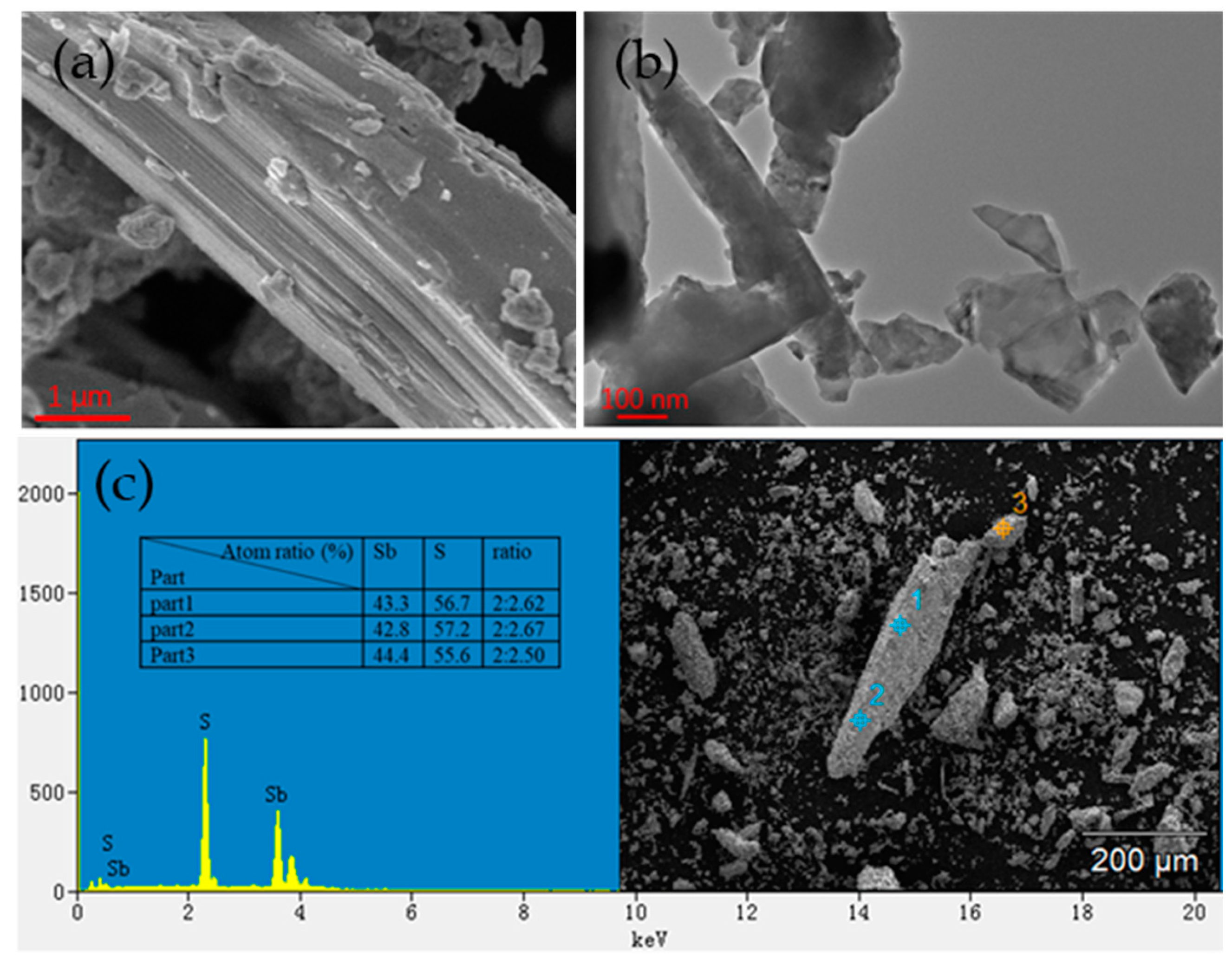
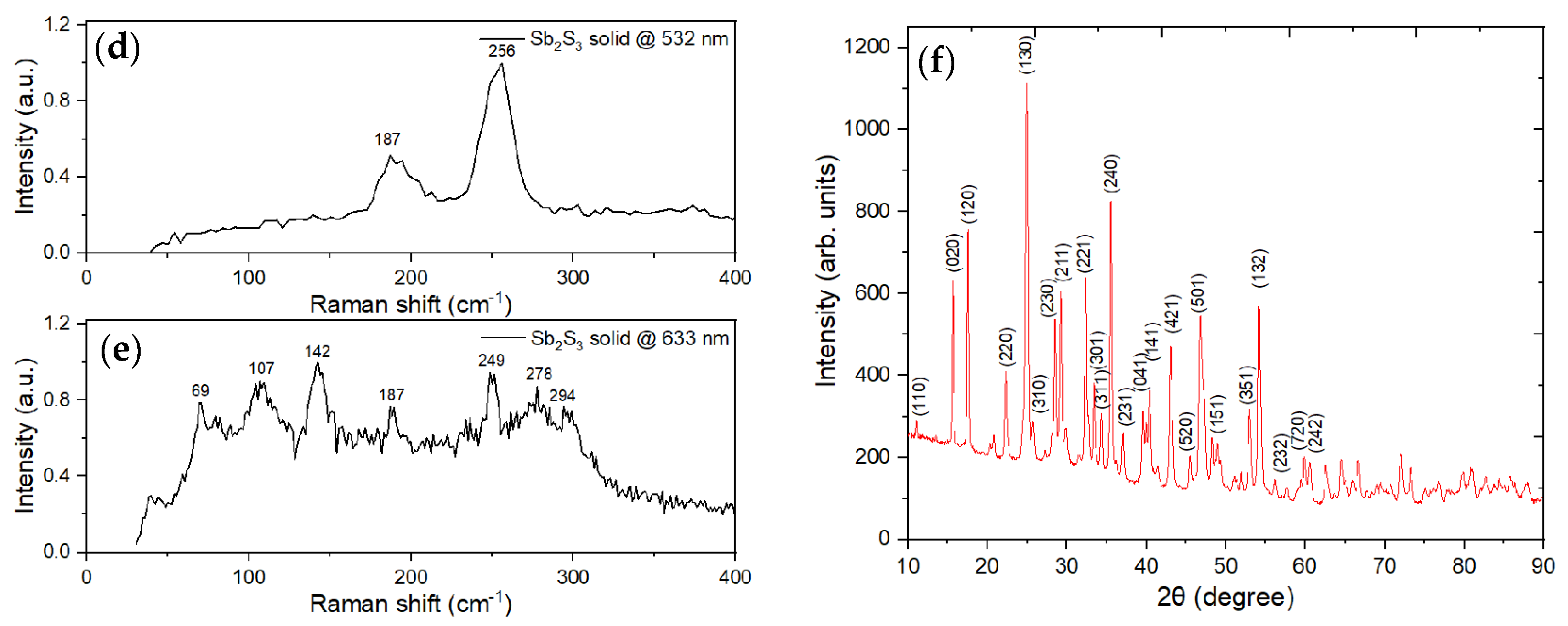


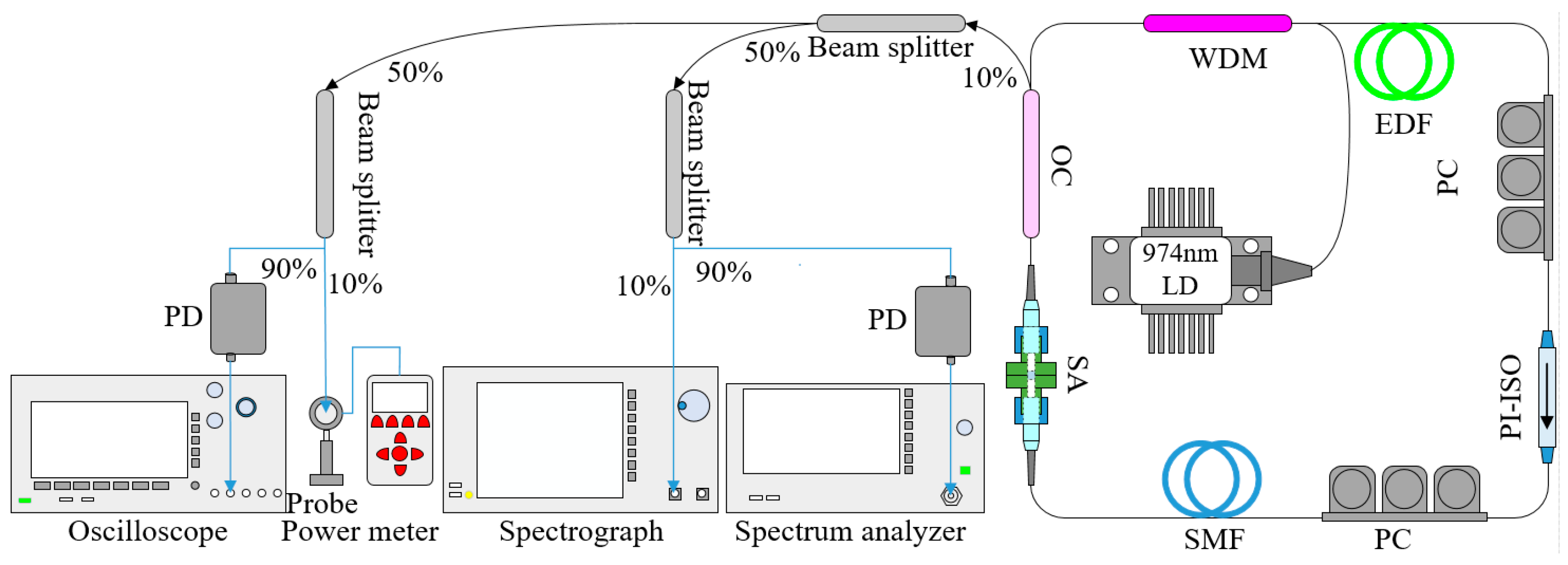
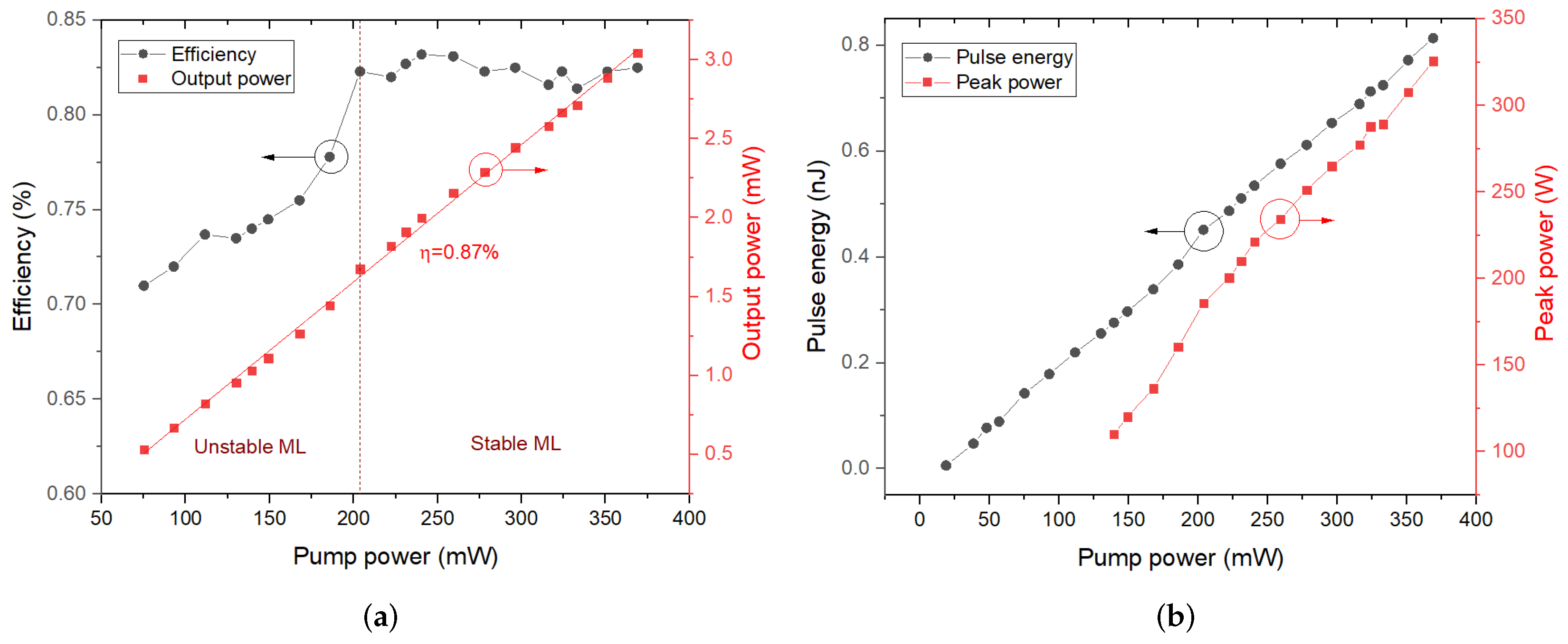
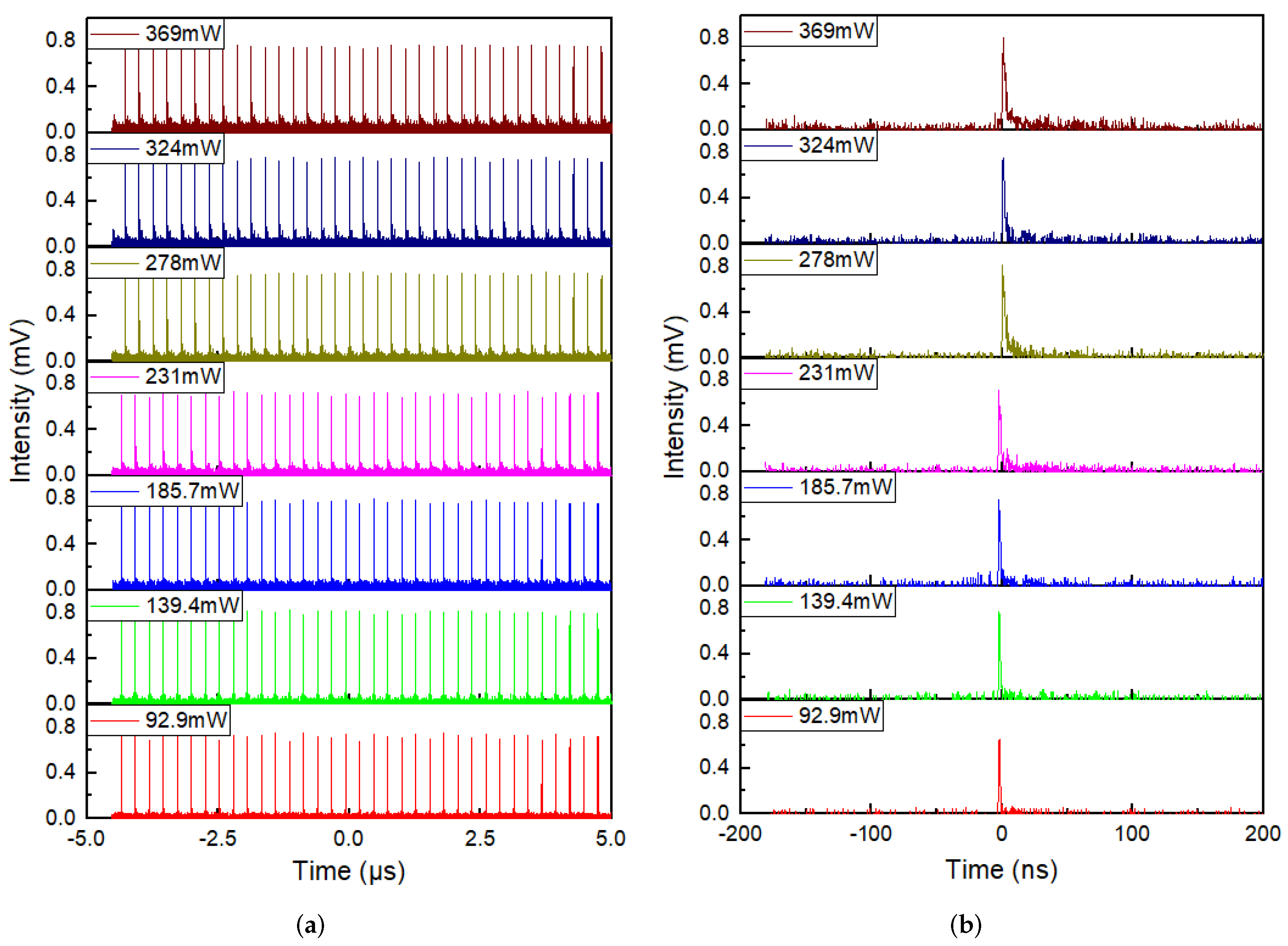
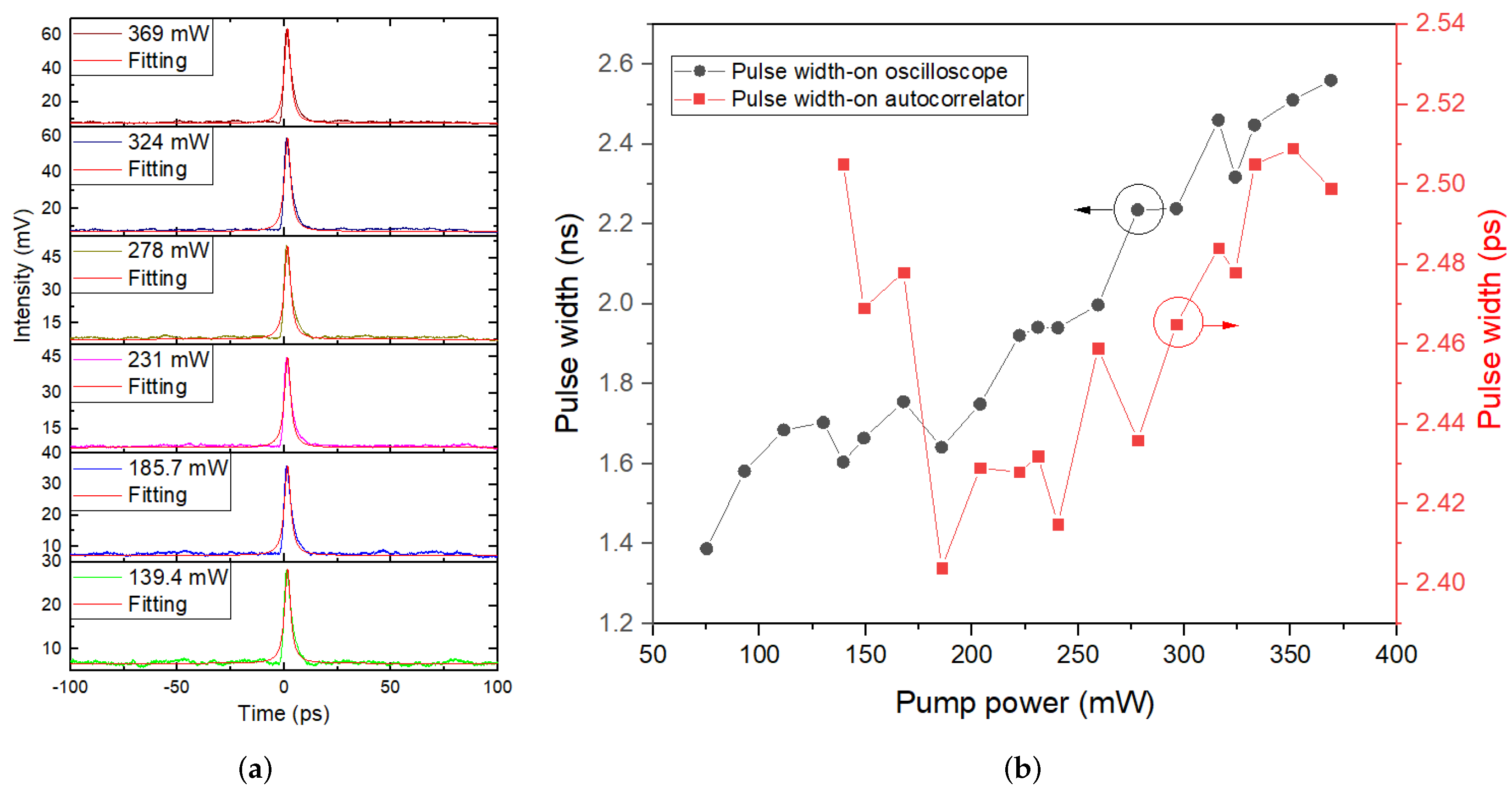

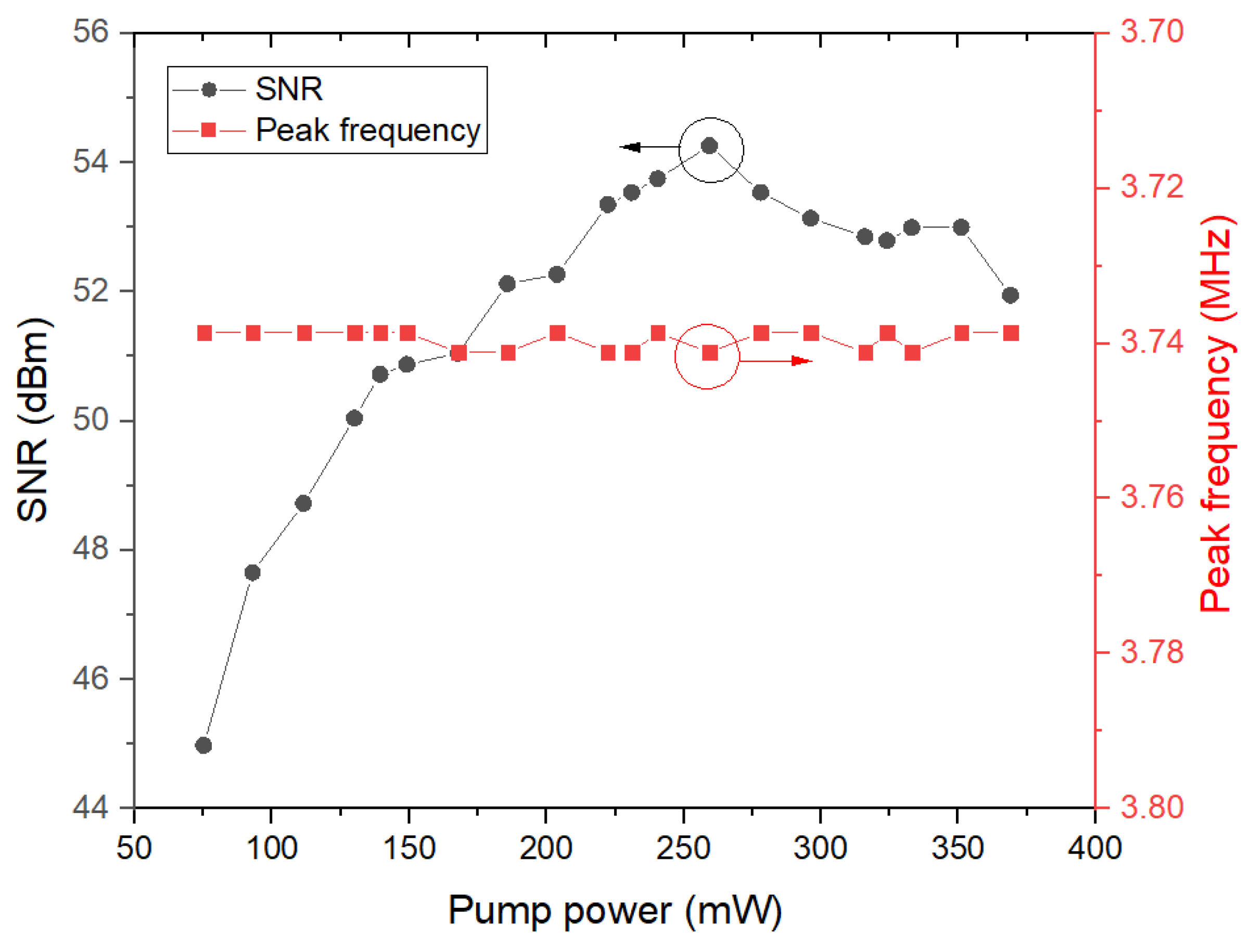
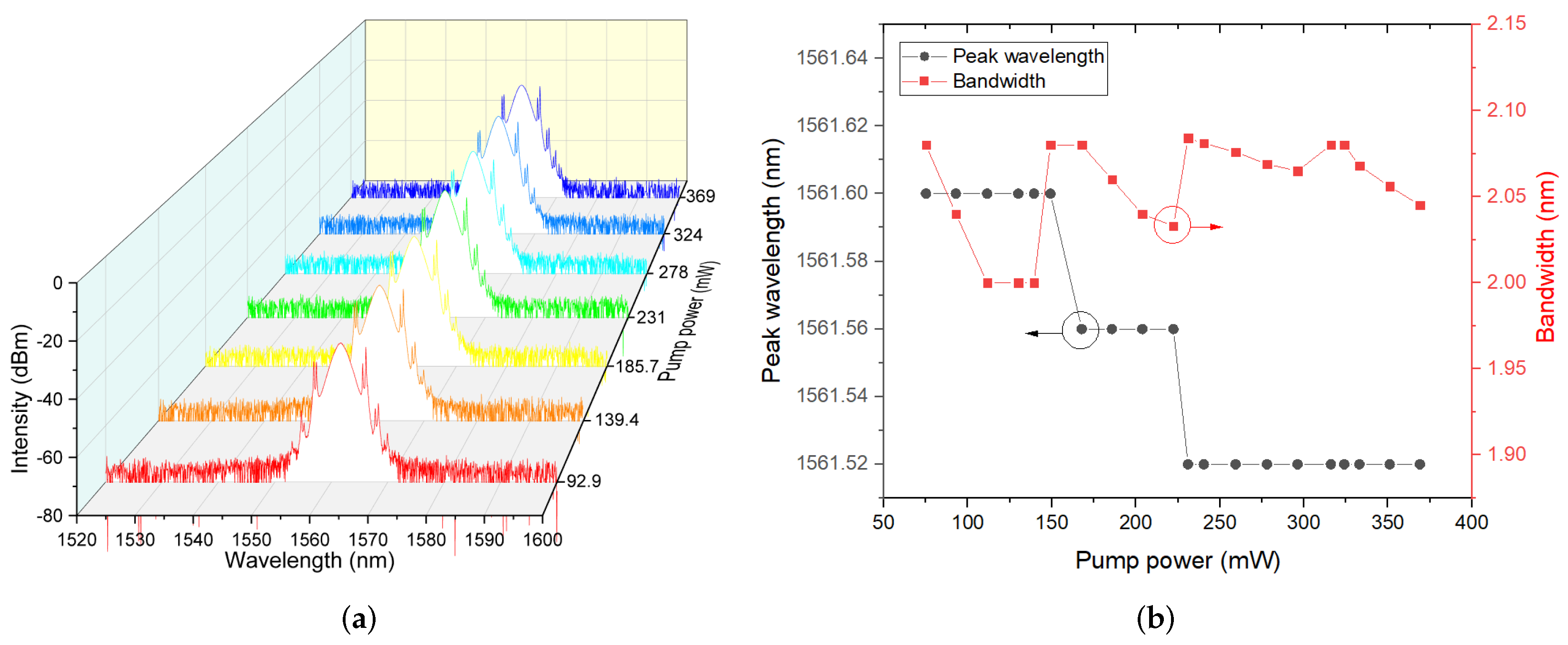
| 2D Mater. | Integration Method | λ nm | Frep MHz | τ Ps | Pave mW | E nJ | ΔT % | SNR dB | Ref. |
|---|---|---|---|---|---|---|---|---|---|
| Graphene | Sandwiched | 1576 | 10.9 | 3.2 | 3.02 | - | - | 40 | [8] |
| Graphene | Microfiber | 1531.3 | 1.89 | 1.21 | 0.45 | - | 4.37 | 60 | [9] |
| GO | Microfiber | 1560 | 7.47 | 18 | 1.2 | - | 5.75 | 70 | [10] |
| BP | Sandwiched | 1561 | 5.268 | 1.438 | - | - | 0.8 | 60 | [14] |
| Bi2Se3 | Sandwiched | 1557.5 | 12.5 | 0.66 | 1.8 | - | 3.9 | 55 | [15] |
| Bi2Te3 | Sandwiched | 1557 | 8.635 | 1.08 | 0.25 | - | 2.0 | 60 | [16] |
| Sb2Te3 | Sandwiched | 1558.6 | 4.75 | 1.8 | 0.5 | 0.105 | - | 60 | [17] |
| MoS2 | SPF | 1568 | 26.02 | 4.98 | - | 0.08 | 2.5 | 63 | [19] |
| MoSe2 | Sandwiched | 1558.25 | 8.028 | 1.45 | 0.44 | 0.0548 | 0.63 | 61.5 | [20] |
| WS2 | SMPCF | 1563.8 | 19.57 | 0.808 | 2.64 | 0.1336 | 3.53 | 60.5 | [21] |
| TiS2 | Microfiber | 1563.3 | 22.7 | 0.812 | - | 0.0253 | 8.3 | 60 | [22] |
| PtS2 | Sandwiched | 1572 | 15.04 | 2.064 | 1.1 | - | 7.0 | 43 | [23] |
| PtSe2 | Microfiber | 1563 | 23.3 | 1.02 | - | 0.53 | 4.9 | 61 | [24] |
| ReS2 | Sandwiched | 1558.6 | 5.48 | 1.6 | 0.4 | - | 0.12 | - | [30] |
| Sb2S3 | Sandwiched | 1561.6 | 3.74 | 2.4 | 3.04 | 0.81 | 4.0 | 54.3 | This work |
Publisher’s Note: MDPI stays neutral with regard to jurisdictional claims in published maps and institutional affiliations. |
© 2022 by the authors. Licensee MDPI, Basel, Switzerland. This article is an open access article distributed under the terms and conditions of the Creative Commons Attribution (CC BY) license (https://creativecommons.org/licenses/by/4.0/).
Share and Cite
Hu, Q.; Chen, X.; Li, M.; Li, P.; Xu, L.; Zhao, H.; Zhang, B.; Liu, J.; Yang, K. Passively Mode-Locked Er-Doped Fiber Laser Based on Sb2S3-PVA Saturable Absorber. Molecules 2022, 27, 745. https://doi.org/10.3390/molecules27030745
Hu Q, Chen X, Li M, Li P, Xu L, Zhao H, Zhang B, Liu J, Yang K. Passively Mode-Locked Er-Doped Fiber Laser Based on Sb2S3-PVA Saturable Absorber. Molecules. 2022; 27(3):745. https://doi.org/10.3390/molecules27030745
Chicago/Turabian StyleHu, Qiongyu, Xiaohan Chen, Ming Li, Ping Li, Liwei Xu, Haoxu Zhao, Bin Zhang, Jing Liu, and Kejian Yang. 2022. "Passively Mode-Locked Er-Doped Fiber Laser Based on Sb2S3-PVA Saturable Absorber" Molecules 27, no. 3: 745. https://doi.org/10.3390/molecules27030745
APA StyleHu, Q., Chen, X., Li, M., Li, P., Xu, L., Zhao, H., Zhang, B., Liu, J., & Yang, K. (2022). Passively Mode-Locked Er-Doped Fiber Laser Based on Sb2S3-PVA Saturable Absorber. Molecules, 27(3), 745. https://doi.org/10.3390/molecules27030745






